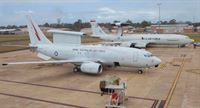Фотографии
-
The E-7A Wedgetail design (foreground) has been selected by a number of other air forces including Turkey, the UK and South Korea
Самолёты на фотографии: Boeing E-3 Sentry - США - 1972Boeing E-7 Wedgetail / Boeing 737 AEW&C - США - 2004
-
Some examples of the RAAF’s P-3C Orion maritime patrol aircraft have been adapted for electronic warfare operations (bottom left of the picture)
Самолёты на фотографии: Boeing P-8 Poseidon - США - 2009Lockheed P-3 Orion - США - 1958
-
The US Navy’s Multi-Intelligence, or Integrated Functional Capability 4-configured MQ-4C Triton UAVs, developed by Northrop Grumman, has been selected by Australia
Самолёты на фотографии: Ryan RQ-4 Global Hawk / MQ-4C Triton - США - 1998
-
Australia is adding significant unmanned ISR capabilities to its forces, having ordered up to 12 MQ-9B SkyGuardians from US manufacturer General Atomics Aeronautical Systems
Самолёты на фотографии: GA-ASI MQ-9 Predator-B / Reaper / Altair / Mariner - США - 2001
-
Initial Operational Capability for the planned fleet of four Gulfstream MC-55As is expected to occur in mid-2023
Самолёты на фотографии: Gulfstream Gulfstream IV/V/G450/G500/G550 - США - 1985
-
Регистрационный номер: A47-004 The first eight Australian P-8A aircraft were delivered in the US Navy’s ‘Increment 2’ baseline configuration, but subsequent aircraft arrived in the definitive, network-ready ‘Increment 3’ configuration
Самолёты на фотографии: Boeing P-8 Poseidon - США - 2009
-
Obtaining and disseminating accurate battlefield information is a critical part in establishing domain awareness superiority
Самолёты на фотографии: Boeing P-8 Poseidon - США - 2009
-
When on operations, ISR aircraft such as the P-8A Poseidon and E-7A Wedgetail feature a number of consoles in the fuselage where specialists can assess the data being collected
Самолёты на фотографии: Boeing P-8 Poseidon - США - 2009
-
Another mission as part of Operation Okra begins as an RAAF E-7A Wedgetail takes off from Australia's main logistics base in the Middle East.
The Royal Australian Air Force has developed multi-layered ISR capabilities and operates a number of aircraft, such as the E-7A WedgetailСамолёты на фотографии: Boeing E-7 Wedgetail / Boeing 737 AEW&C - США - 2004
Статьи
- Focus: UAV, Rotary, Business, Technology
- News: Commercial, Military
- A.Drwiega - Heralding nextgen rotorcraft
- J.Lake - Defiant Design
- M.Broadbent - From fringe to mainstream
- M.Broadbent, R.Sandhu - Air architecture
- M.-O.Sabourin - Positioning for the future
- N.Pittaway - The intelligence edge
- R.Schuurman - Rude awakening for Dreamliner
- S.Gourley - V for Valor
- T.Batchelor - Safety first
- T.Batchelor, P.Pilidis - Powering on
- T.Batchelor, T.Bridge - The electric sky jeep
- T.Compston - Astro Wars








